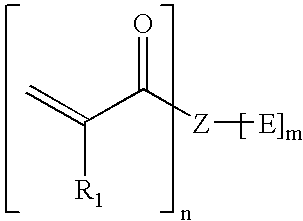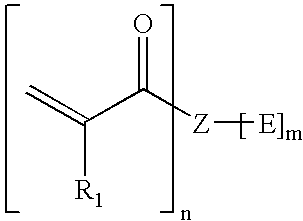Polymerizable compounds and compositions
a polymerizable and compound technology, applied in the field of polymerizable macromonomers and dental and medical compositions, can solve the problems of high water solubility, excessive opacity, low abrasion resistance, etc., and achieve high fluoride ion release, high water solubility, and moderate adhesion.
- Summary
- Abstract
- Description
- Claims
- Application Information
AI Technical Summary
Benefits of technology
Problems solved by technology
Method used
Image
Examples
reference example 1
The macromonomer of formula M-1wherein n is 1, R is —OC6H4—C(CH3)2—C6H4O—, R1 is —CH3, R2 is —(CH2)4— is referred to hereinafter as macromonomer M-1A and is prepared by reacting 150.000 g (0.441 mol) bisphenol-A diglycidyl ether, 32.200 g (0.220 mol) adipic acid and 2,000 g triethylbenzylammoniumchloride for four hours at 80° C. while stirring. To the obtained glycidyl terminated prepolymer are added 37.900 g (0.441 mol) methacrylic acid and 0.444 g 2.6-di-tert.-butyl-p-cresol and are reacted for another four hours at 80° C. The methacrylate terminated macromonomer is soluble in organic solvents such as chloroform, DMF and THF. In the IR-spectrum no absorption of epoxide groups at ν=915 and 3050 cm−1 is observed. Absorption of ester groups is seen at ν=1720 cm−1. In the 1 H NMR spectrum are found signals of the olefinic double bond at δ(CH2=)=6,137 / 6,119 / 6,115 ppm and at δ(CH2=)=5,587 / 5,582 / 5,555 / 5,548 ppm.
reference example 2
Preparation of the macromonomer of formula M-1 B wherein E is hydroxyl, n is 1, R is —O(CH2)4—, R1 is —CH3, R2 is —(CH2)4—.
200.00 g (0.99 mol) butanediol diglycidyl ether, 72.26 g (0.49 mol) adipic acid, 85.13 g (0.99 mol) methacrylic acid, 4.72 g triethylbenzylammoniumchloride and 0.60 g 2,6-di-tert.-butyl-p-cresol are stirred together and heated for four hours at 90° C. The obtained methacrylate terminated macromonomer is soluble in organic solvents such as chloroform, DMF and THF. In the IR-spectrum no absorption of epoxide groups at 915 and 3050 cm−1 is observed. Absorption of ester groups is seen at 1720cm−1. The viscosity measured with a Bohlin rheometer is ηdyn=3.3 Pas (25° C.).
reference example 3
Preparation of the macromonomer of formula M-1F wherein E is hydroxyl, n is 1, R is —OC6H4—CH2—C6H4—, R1 is —CH3, R2 is —(CH2)4—.
100.00 g (0.32 mol) bisphenol-F diglycidyl ether, 23.39 g (0.16 mol) adipic acid, 27.56 g (0.32 mol) methacrylic acid, 65.47 g triethylenglycol dimethacrylate, 1.53 g triethylbenzylammoniumchloride and 0.30 g 2,6-di-tert.-butyl-p-cresol are stirred together and heated for four hours at 90° C. The obtained methacrylate terminated macromonomer is soluble in organic solvents such as chloroform, DMF and THF. In the IR-spectrum no absorption of epoxide groups at 915 and 3050 cm−1 is observed. Absorption of ester groups is seen at 1720 cm−1. The viscosity measured with a Bohlin rheometer is ηdyn=3.6 Pas (25° C.).
PUM
| Property | Measurement | Unit |
|---|---|---|
| glass transition temperatures | aaaaa | aaaaa |
| glass transition temperatures | aaaaa | aaaaa |
| temperature | aaaaa | aaaaa |
Abstract
Description
Claims
Application Information
 Login to View More
Login to View More - R&D
- Intellectual Property
- Life Sciences
- Materials
- Tech Scout
- Unparalleled Data Quality
- Higher Quality Content
- 60% Fewer Hallucinations
Browse by: Latest US Patents, China's latest patents, Technical Efficacy Thesaurus, Application Domain, Technology Topic, Popular Technical Reports.
© 2025 PatSnap. All rights reserved.Legal|Privacy policy|Modern Slavery Act Transparency Statement|Sitemap|About US| Contact US: help@patsnap.com



